cultură şi spiritualitate
***
News of the calamitous fall of Jerusalem sparked grief and outrage in the West. Pope Urban III was said to have died of a heart attack at the news and his successor, Gregory VIII, issued an emotive crusade appeal and the rulers of Europe began to organise their forces. Frederick Barbarossa's German army successfully defeated the Seljuk Turks in Asia Minor only for the emperor to drown crossing a river in southern Turkey. Soon afterwards many of the Germans died of sickness and Saladin escaped facing this formidable enemy. The Franks in the Levant had managed to cling onto the city of Tyre and then besieged the most important port on the coast, Acre. This provided a target for western forces and it was here in the summer of 1190 that Philip Augustus and Richard the Lionheart landed. The siege had lasted almost two years and the arrival of the two western kings and their troops gave the Christians the momentum they needed. The city surrendered and Saladin's prestige was badly dented. Philip soon returned home and while Richard made two attempts to march on Jerusalem, fears as to its long-term prospects after he left meant that the holy city remained in Muslim hands. Thus the Third Crusade failed in its ultimate objective, although it did at least allow the Franks to recover a strip of lands along the coast to provide a springboard for future expeditions. For his part, Saladin had suffered a series of military setbacks but, crucially, he had held onto Jerusalem for Islam.

The pontificate of Innocent III (1198-1216) saw another phase in the expansion of crusading. Campaigns in the Baltic advanced further and the holy war in Iberia stepped forwards too. In 1195 Muslims had crushed Christian forces at the Battle of Alarcos, which, so soon after the disaster at Hattin, seemed to show God's deep displeasure with his people. By 1212, however, the rulers of Iberia managed to pull together to rout the Muslims at the Battle of Las Navas de Tolosa to seal a major step in the recovery of the peninsula. That said, the particular cultural, political and religious make-up of the region mean that it would be wrong, as in the Holy Land, to characterise relations between religious groups as constant warfare, a situation outlined by Robert Burns and Paul Chevedden. In southern France, meanwhile, efforts to curb the Cathar heresy had failed and, in a bid to defeat this sinister threat to the Church in its own backyard, Innocent authorised a crusade to the area. See the piece by Richard Cavendish. Catharism was a dualist faith, albeit with a few links to mainstream Christian practice, but it also had its own hierarchy and was intent upon replacing the existing elite. Years of warfare ensued as the crusaders, led by Simon de Monfort, sought to drive the Cathars out, but ultimately their roots in southern French society meant they could endure and it was only the more pervasive techniques of the Inquisition, initiated in the 1240s, that succeeded where force had failed.
The most infamous episode of the age was the Fourth Crusade (1202-04) which saw another effort to recover Jerusalem end up sacking Constantinople, the greatest Christian city in the world. Jonathan Phillips describes this episode. The reasons for this were a combination of long-standing tensions between the Latin (Catholic) Church and the Greek Orthodox; the need for the crusaders to fulfil the terms of a wildly over-optimistic contract for transportation to the Levant with the Venetians and the offer to pay this off by a claimant to the Byzantine throne. This combination of circumstances brought the crusaders to the walls of Constantinople and when their young candidate was murdered and the locals turned definitively against them they attacked and stormed the city. At first Innocent was delighted that Constantinople was under Latin authority but as he learned of the violence and looting that had accompanied the conquest he was horrified and castigated the crusaders for 'the perversion of their pilgrimage'.
 Capture of Constantinople by the Fourth Crusade in 1204
Capture of Constantinople by the Fourth Crusade in 1204
One consequence of 1204 was the creation of a series of Frankish States in Greece that, over time, also needed support. Thus, in the course of the 13th century, crusades were preached against these Christians, although by 1261 Constantinople itself was back in Greek hands.
***
In spite of this series of disasters, it is interesting to see that crusading remained an attractive concept, something made manifest by the near-legendary Children's Crusade of 1212. Inspired by divine visions, two groups of young peasants (best described as youths, rather than children) gathered around Cologne and near Chartres in the belief that their purity would ensure divine approval and enable them to recover the Holy Land. The German group crossed the Alps and some reached the port of Genoa, where the harsh realities of having no money or real hope of achieving anything was made plain when they were refused passage to the East and the entire enterprise collapsed.
Thus, the early 13th century was characterised by the diversity of crusading. Holy war was proving a flexible and adaptable concept that allowed the Church to direct force against its enemies on many fronts. The rationale of crusading, as a defensive act to protect Christians, could be refined to apply specifically to the Catholic Church and thus when the papacy came into conflict with Emperor Frederick II over the control of southern Italy it eventually called a crusade against him. Frederick had already been excommunicated for failing to fulfil his promises to take part in the Fifth Crusade. This expedition had achieved the original intention of the Fourth Crusade by invading Egypt but became bogged down outside the port of Damietta before a poorly executed attempt to march on Cairo collapsed. Frederick's attempts to make good this were frustrated by genuine ill health but by this time the papacy had lost patience with him. Recovered, Frederick went to the Holy Land as, by this time, king of Jerusalem (by marriage to the heiress to the throne) where – irony of ironies – as an excommunicate, he negotiated the peaceful restoration of Jerusalem to the Christians. His diplomatic skills (he spoke Arabic), the danger posed by his considerable resources as well as the divisions in the Muslim world in the decades after Saladin's death, enabled him to accomplish this. A brief period of better relations between pope and emperor followed, but by 1245 the curia described him as a heretic and authorised the preaching of a crusade against him.
Aside from the plethora of crusading expeditions that took place over the centuries, we should also remember that the launch of such campaigns had a profound impact on the lands and people from whence they came, something covered by Christopher Tyerman. Crusading required substantial levels of financial support and this, over time, saw the emergence of national taxes to support such efforts, as well as efforts to raise money from within the Church itself. The absence of a large number of senior nobles and churchmen could affect the political balance of an area, with opportunities for women to act as regents or for unscrupulous neighbours to defy ecclesiastical legislation and to try to take the lands of absent crusaders. The death or disappearance of a crusader, be they a minor figure or an emperor, obviously carried deep personal tragedy for those they had left behind, but might also precipitate instability and change.

The previous year, Jerusalem had fallen back into Muslim hands and this was the principal prompt for what turned out to be the greatest crusade expedition of the century (known as the Seventh Crusade) led by King (later Saint) Louis IX of France. Simon Lloyd outlines Louis's crusading career. Well financed and carefully prepared and with an early victory at Damietta, this campaign appeared to be set fair only for a reckless charge by Louis's brother at the Battle of Mansourah to weaken the crusaders' forces. This, coupled with hardening Muslim resistance, brought the expedition to a halt and, starving and sick, they were forced to surrender. Louis remained in the Holy Land for a further four years – a sign of his guilt at the failure of the campaign, but also a remarkable commitment for a European monarch to be absent from his home for a total of six years – trying to bolster the defences of the Latin kingdom. By this time, with the Latins largely confined to the coastal strip the settlers relied more and more on massive fortifications and it was during the 13th century that mighty castles such as Krak des Chevaliers, Saphet and Chastel Pelerin, as well as the immense urban fortifications of Acre, took shape.
***
By this stage the political complexion of the Middle East was changing. The Mongol invaders added another dimension to the struggle as they conquered much of the Muslim world to the East; they had also briefly threatened Eastern Europe with savage incursions in 1240-41 (which also prompted a crusade appeal). Saladin's successors were displaced by the Mamluks, the former slave-soldiers, whose figurehead, the sultan Baibars, was a ferocious exponent of holy war and did much to bring the crusader states to their knees over the next two decades. James Waterson describes their advance. Bouts of in-fighting among the Frankish nobility, further complicated by the involvement of the Italian trading cities and the Military Orders served to further weaken the Latin States and finally, in 1291, the Sultan al-Ashraf smashed into the city of Acre to end the Christian hold on the Holy Land.
Some historians used to regard this as the end of the crusades but, as noted above, since the 1980s there has been a broad recognition that this was not the case, not least because of the series of plans made to try to recover the Holy Land during the 14th century. Elsewhere crusading was still a powerful idea, not least in northern Europe, where the Teutonic Knights (originally founded in the Holy Land) had transferred their interests and where they had created what was effectively an autonomous state. By the early 15th century, however, their enemies in the region were starting to Christianise anyway and thus it became impossible to justify continued conflict in terms of holy war. The success of Las Navas de Tolosa had effectively pinned the Muslims down to the very south of the Iberian peninsula, but it took until 1492 when Ferdinand and Isabella brought the full strength of the Spanish crown to bear upon Granada that the reconquest was completed. Plans to recover the Holy Land had not entirely died out and in a spirit of religious devotion, Christopher Columbus set out the same year hoping to find a route to the Indies that would enable him to reach Jerusalem from the East.
The 14th century began with high drama: the arrest and imprisonment of the Knights Templar on charges of heresy, a story related by Helen Nicholson. A combination of lax religious observance and their failure to protect the Holy Land had made them vulnerable. This uncomfortable situation, coupled with the French crown owing them huge sums of money (the Templars had emerged as a powerful banking institution) meant that the manipulative and relentless Philip IV of France could pressure Pope Clement V into suppressing the Order in 1312 and one of the great institutions of the medieval age was terminated.
 Modern painting of Mehmed II and the Ottoman Army approaching Constantinople with a giant bombard, by Fausto Zonaro
Modern painting of Mehmed II and the Ottoman Army approaching Constantinople with a giant bombard, by Fausto Zonaro
Crusading within Europe itself had continued to mutate, too. The papacy had issued crusading indulgences on many occasions during its own struggles against both political enemies and against heretical groups such as the Hussites of Bohemia. The main threat to Christendom by this time, however, was from the Ottoman Turks, who, as Judith Herrin relates, captured Constantinople in 1453. Numerous efforts were made to draw together the leaders of the Latin West, but the growing power of nation states and their increasingly engrained conflicts, exemplified by the Hundred Years' War, meant that there was little appetite for the kind of Europe-wide response that had been seen in 1187, for example. Nigel Saul outlines this period of crusading history in his article.
Certain dynasties such as the dukes of Burgundy, were enthusiastic about the idea of crusading and a couple of reasonably-sized expeditions took place, although the Burgundians and the Hungarians were thrashed at Nicopolis in Bulgaria in 1396. By the middle of the 15th century the Ottomans had already twice besieged Constantinople and in 1453 Sultan Mehmet II brought forwards an immense army to achieve his aim. Last-minute appeals to the West brought insufficient help and the city fell in May. The Emperor Charles V invoked the crusading spirit in his defence of Vienna in 1529, although this struggle resembled more of an imperial fight rather than a holy war. Crusading had almost run its course; people had become increasingly cynical about the Church's sale of indulgences. The advance of the Reformation was another obvious blow to the idea, with crusading being viewed as a manipulative and money-making device of the Catholic Church. By the late 16th century the last real vestiges of the movement could be seen; the Spanish Armada of 1588 benefitted from crusade indulgences, while the Knights Hospitaller, who had first ruled Rhodes from 1306 to 1522 before making their base on Malta, inspired a remarkable victory over an Ottoman fleet at the Battle of Lepanto in 1571. Jonathan Riley-Smith relates the knights' story. The Hospitallers of Malta had also survived a huge Turkish siege in 1480 and their existence served as a long-lasting relic of the original crusading conflict until Napoleon Bonaparte extinguished their rule of the island in 1798.
***
Crusading survived in the memory and the imagination of the peoples of western Europe and the Middle East. In the former, it regained profile through the romantic literature of writers such as Sir Walter Scott and, as lands in the Middle East fell to the imperialist empires of the age, the French, in particular, chose to draw links with their crusading past. The word became a shorthand for a cause with moral right, be it in a non-military context, such as a crusade against drink, or in the horrors of the First World War. General Franco's ties with the Catholic Church in Spain invoked crusading ideology in perhaps the closest modern incarnation of the idea and it remains a word in common usage today.
In the Muslim world, the memory of the Crusades faded, although did not disappear, from view and Saladin continued to be a figure held out as an exemplar of a great ruler. In the context of the 19th century, the Europeans' invocation of the past built upon this existing memory and meant that the image of hostile, aggressive westerners seeking to conquer Muslim or Arab lands became extremely potent for Islamists and Arab Nationalist leaders alike, and Saladin, as the man who recaptured Jerusalem, stands as the man to aspire to. Articles by Jonathan Phillips and Umej Bhatia cover the memory and the legacy of the crusades to bring the story down to modern times.
Jonathan Phillips is Professor of Crusading History at Royal Holloway University of London and the author of Holy Warriors: A Modern History of the Crusades (Vintage, 2010).
- See more at: http://www.historytoday.com/jonathan-phillips/crusades-complete-his...
Adaugă un comentariu
© 2024 Created by altmarius.
Oferit de
![]()
Embleme | Raportare eroare | Termeni de utilizare a serviciilor













Pentru a putea adăuga comentarii trebuie să fii membru al altmarius !
Alătură-te reţelei altmarius